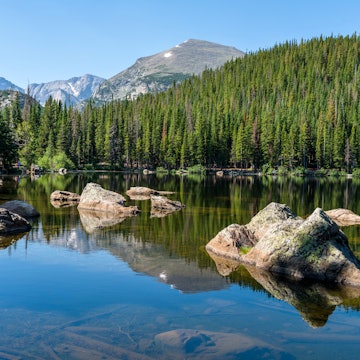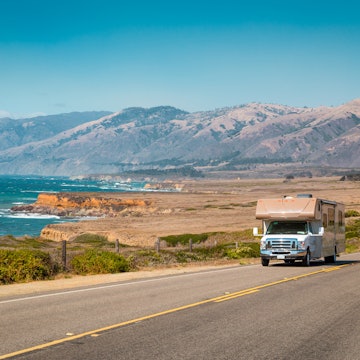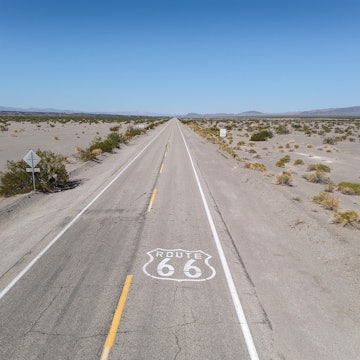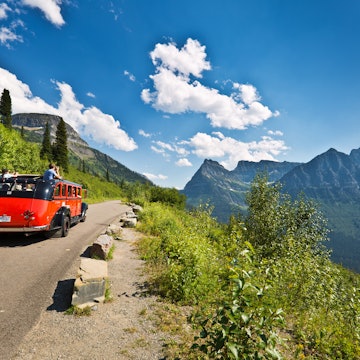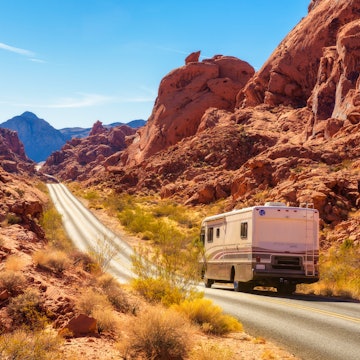
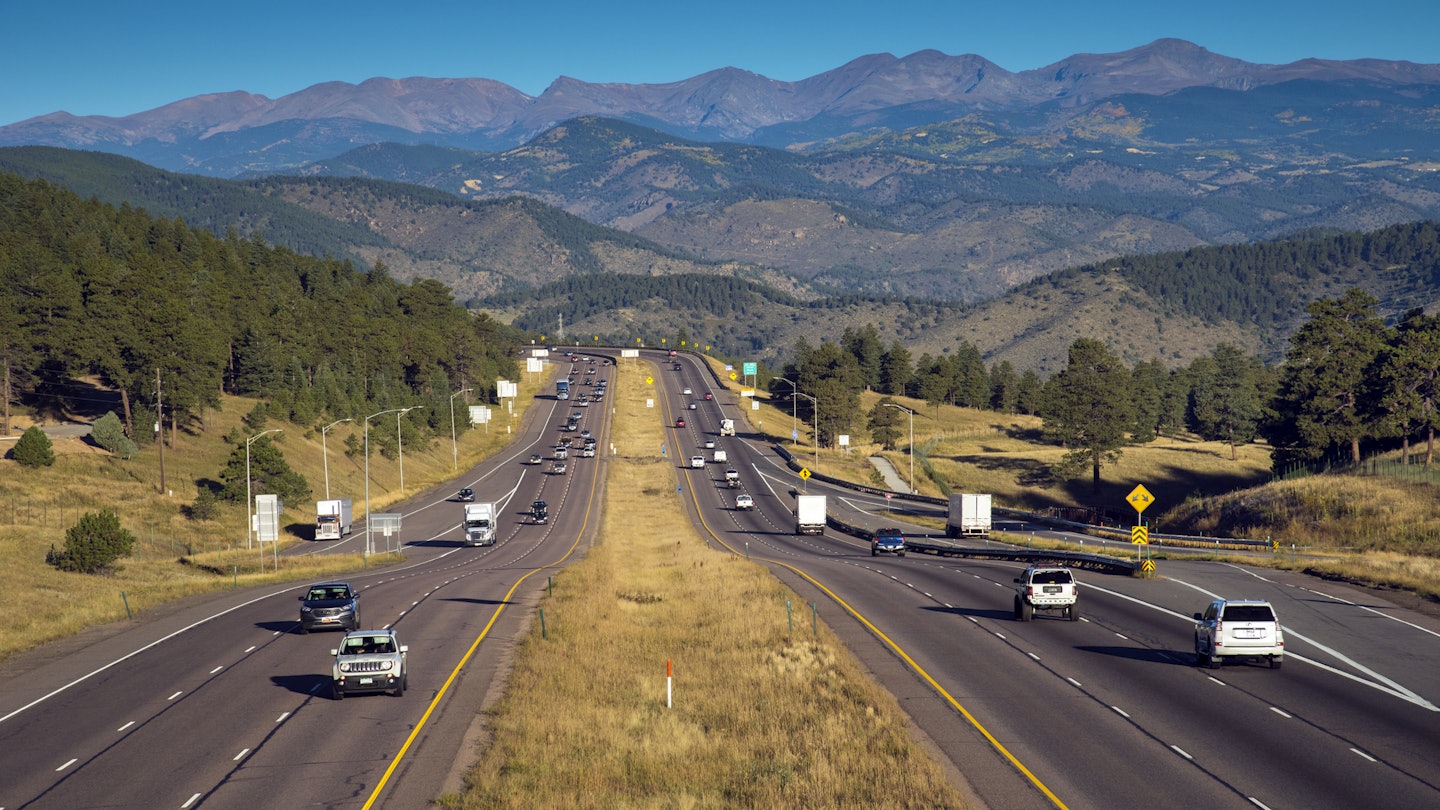
Even a short drive on the highway can be a scenic adventure in the Centennial State. John Coletti/Getty Images
Colorado is only the 8th biggest US state, but it covers more space than Great Britain, and its diverse terrain spans mountains, deserts, plains and forested wilderness. With big distances to cover, many travelers play it safe and come by car or RV.
However, Denver is well connected to other cities in the central US by buses, trains and planes, and if you’re not 100% comfortable navigating curvy mountain roads, especially when conditions are icy, you might want to leave the driving to the professionals anyway.
That said, if you’re planning to stay in one place for most of your trip, you can easily get around by walking, biking and taking public transportation, and the Centennial State has several sightseeing trains that are well worth basing a trip around. As you start planning your next adventure, here’s everything you need to know about getting around in Colorado.

Cover a lot of ground in Colorado by driving
Colorado spans an impressive 103,641 sq miles, encompassing many diverse landscapes, from craggy peaks to flat plains to rugged red rock formations. If you’re planning to see multiple parts of the state on one vacation, then driving is your best bet, whether you road trip from home or fly into Denver International Airport and rent a car on arrival.
Two of the most important thoroughfares in Colorado are Interstate 25, which runs north to south, and Interstate 70, which runs east to west. The two roads meet in Denver and many popular places to visit in Colorado are accessible via these two well-traveled routes. This means you’ll find plenty of services, restaurants and scenic overlooks along the way. On the flip side, however, because so many drivers use the Interstates, they regularly get backed up with traffic in certain spots.
For a more peaceful road trip, consider driving along one of Colorado’s 26 scenic and historic byways, of which 13 are designated as "America's Byways" by the federal government. They can’t take you everywhere in the state, but they can get you pretty close to most destinations — and you’ll see some truly stunning sights and learn something new along the way.
Parking is generally easy to find in Colorado, with a few notable exceptions. You may find yourself driving around the block a few times to find parking in many neighborhoods in Denver, especially on the weekends. However, with enough patience (and a willingness to spend some cash), you’ll eventually be able to find a spot in a garage or parking lot.
Parking can also be an issue in some mountain towns and at most ski resorts, which are short on space because of their rugged surroundings. Many ski resorts have now added satellite parking lots and free shuttles to bring you right to the chairlifts, though this can add a little transit time to your ski day. If you’re planning to spend the night, you’ll likely have to pay to park your vehicle in the hotel garage (and some hotels only offer valet parking).

Relax while taking the bus
If you don’t want to pay to rent a car, or you’re just not comfortable driving, buses can be a good alternative. Greyhound coaches link Denver to other major US cities, and on arrival in Denver, Regional Transportation District buses and light rail services can get you pretty much everywhere you want to go in town.
From Denver, you can also ride the bus to many other destinations around the state. The Colorado Department of Transportation (CDOT) operates several Bustang routes that connect Denver with Colorado Springs to the south, Fort Collins to the north and Grand Junction to the west. Outside of Denver, CDOT also offers connections between larger Colorado cities, such as Telluride to Grand Junction and Lamar to Colorado Springs. In the winter, CDOT’s Snowstang buses transport skiers and snowboarders to various Colorado ski areas.
Many mountain towns, including Aspen and Vail, also have reliable bus systems — and they’re typically free or very affordable. You can take the bus to many popular ski areas and hiking trailheads, where car parking spaces typically fill up quickly. Buses are a great option if you’re unfamiliar with driving in snow or if you just prefer the freedom of parking your car at your hotel, then not having to worry about it for the rest of your trip. Hotels in many ski towns also have free shuttles ferrying guests around town.

Engage your senses on foot, bike or scooter
If you want to get around on your own timetable and enjoy unobstructed views of your surroundings, consider walking, biking or riding a scooter. These transportation modes are perfect for immersing yourself in Colorado’s scenery and using more of your senses — when you walk, bike or scooter, you can stop to take photos, smell wildflowers and feel the breeze on your face.
Several Colorado towns have bikeshare programs. These are specifically designed (and priced) for local transportation — like the trip from your hotel to a museum — but are less useful for taking a leisurely, multi-hour jaunt on a bike path. For that type of ride, you’ll want to arrange a half-day or full-day rental from a local bike shop.
In Denver, you can rent electric bikes (and scooters) through a city partnership with Lyft and Lime. In Aspen, the nonprofit WE-Cycle bikeshare program offers both e-bikes and pedal bikes. And in Vail and the surrounding towns, you can rent e-bikes through a program called Shift Bikes. You can also cross the countryside in thrilling fashion on mountain bike trails all over Colorado, and on tracks and road routes through state parks and national reserves such as Rocky Mountain National Park.
If your lodging is centrally located, in many towns you’ll be able to walk to shops, restaurants, bars and attractions. This is true even in the winter, since many Colorado ski resorts were designed with pedestrians in mind (some even have heated sidewalks for quickly melting away snow and ice). The state is also home to multiple pedestrian malls where cars are prohibited, including Boulder’s Pearl Street Mall, Denver’s 16th Street Mall, Aspen’s Pedestrian Mall and Fort Collins’ Old Town Square.
Get around town by hailing a ride
Rideshare platforms such as Lyft and Uber operate throughout the state, though you’ll find the highest numbers of drivers in heavily populated areas such Denver, and college towns such as Boulder and Fort Collins. The same goes for conventional taxis and limousine services. If you try to request a ride in some of Colorado’s more rural and mountainous areas, you likely won’t have much luck.

Marvel at Colorado’s beauty on the railways
Colorado is famed for its beautiful mountain scenery, and several sightseeing trains (or trains that double as public transportation and sightseeing excursions) will take you through the best of it.
Amtrak’s California Zephyr train — which connects Chicago to San Francisco — runs right through the heart of the state from east to west. If you don’t want to take the entire, multi-day trip, consider picking up the train in Denver, then riding it to Glenwood Springs and back again. It’s about a six-hour trip each way, and Glenwood Springs is ideal for a weekend getaway, being packed with historic hotels and hot springs where you can recharge.
The Canadian Rocky Mountaineer train company also has a Colorado-focused itinerary that travels between Denver and Moab, Utah, with a stop in Glenwood Springs along the way.

Day trip by rail on classic vintage trains
Even if you’re not planning to take the train as a way to get from A to B, Colorado has some rewarding day trips by train that will add extra atmosphere to your vacation itinerary.
In the southwestern corner of the state, the Durango & Silverton Narrow Gauge Railroad offers a scenic rail tour between these two historic towns. The entire excursion — which is particularly stunning in the fall when the aspen trees change color — takes about nine hours out and back, which includes a two-hour stopover in the historic mining town of Silverton.
The Royal Gorge Route Railroad, meanwhile, offers a unique view of the Royal Gorge, an impressive, 1200ft-deep crevasse carved out over millions of years by the Arkansas River in south-central Colorado. The train runs right next to the river at the bottom of the ravine, and when you look up, you can see the canyon walls towering high above you. You’ll also pass beneath the Royal Gorge Bridge, which dates back to 1929 and is the highest suspension bridge in the nation.
Cross the state quickly by flying
While it's important to consider the carbon footprint, it’s possible to fly to get around quickly in Colorado. For instance, from Denver International Airport, you can fly to Telluride, Vail, Aspen, Colorado Springs, Steamboat Springs, Grand Junction and other Colorado towns. United/United Express, Southwest, Southern Airways Express and Denver Air Connection are the primary airlines offering in-state flights.

Accessible transportation in Colorado
Like many US states, Colorado is working to become more accessible to travelers with disabilities. Public transit systems, including RTD in Denver, CDOT throughout the state, and many local and regional bus networks, are designed to be able to accommodate wheelchairs and other mobility devices.
Bus drivers are also trained to help guests get on and off the bus, secure their mobility devices and navigate the system. Service animals are welcome, and most buses offer priority seating for riders with disabilities. On RTD buses and trains, personal attendants can accompany a person with a disability for free.
The state has numerous wheelchair-friendly hiking trails, and travelers can filter for these routes on the free Colorado Trail Explorer (COTREX) app and website. In addition, specialized wheelchairs are available for exploring some public lands, including balloon-tire wheelchairs at Great Sand Dunes National Park and Preserve and track-chairs at Staunton State Park.
Adaptive sports organizations offer a wide variety of programs in summer and winter, from downhill mountain biking in Crested Butte to waterskiing at Boulder Reservoir.










